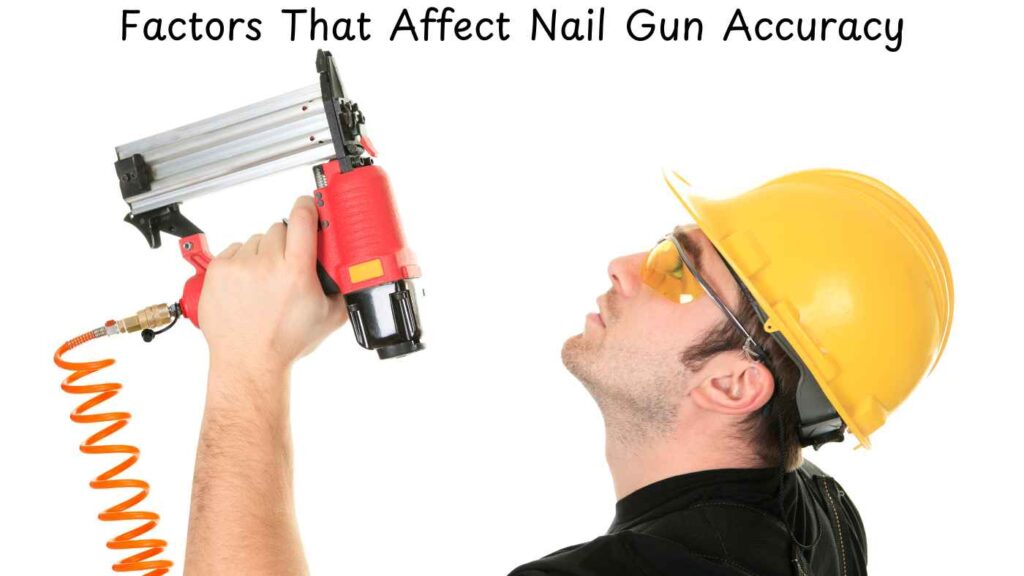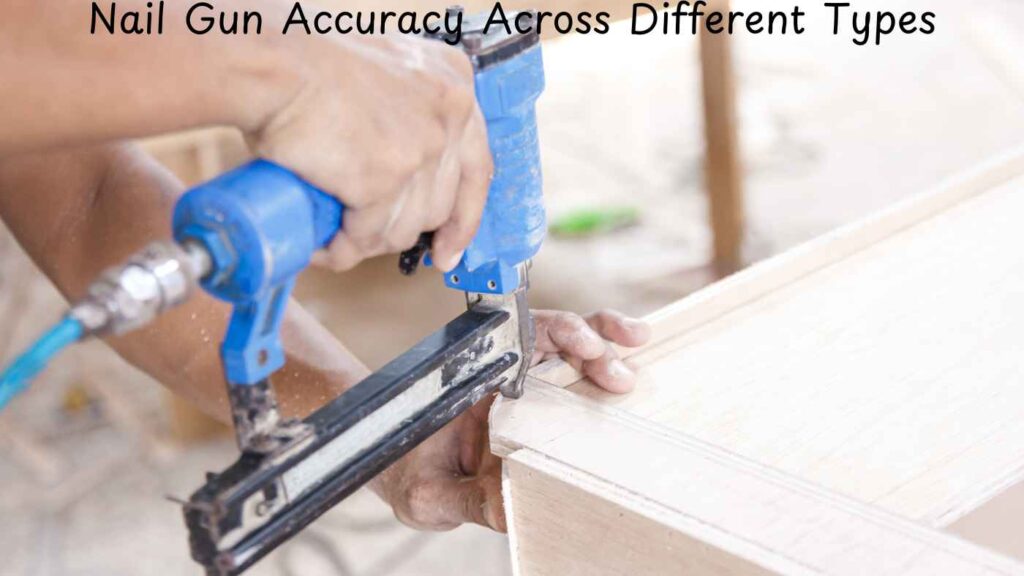Nail guns have changed the way people build and work with wood. They make jobs faster, easier, and stronger. But hitting the right spot is just as important as power.
No one wants nails going the wrong way missing the target, or even ruining the wood. Whether installing trim, building a wall, or doing detailed woodwork, correctly placing nails is key to a great final look.
So, how accurate is a nail gun? The short answer: it depends. The types of nail guns, how you use them, and the kind of wood or material you’re working with all affect accuracy.
Factors That Affect Nail Gun Accuracy

Getting accurate results with a nail gun depends on many things, like the type of nail gun and the material you’re working with.
Below, we have explained the key factors that affect accuracy and how to improve them.
Type of Nail Gun
Each nail gun is made for different jobs, and some are more accurate than others. Picking the right one helps you get better results.
- Framing Nailers: These are made for strength and speed, not accuracy. They drive big nails into thick materials which can sometimes lead to nails going slightly off course.
- Finish Nailers: These are used for trim, molding, and cabinets, and they are more accurate than framing nailers. They use smaller nails for cleaner and more controlled work.
- Brad Nailers: These nailers use smaller nails that are great for delicate work like attaching thin trim. They are perfect for projects that need careful nail placement.
- Pin Nailers: The most accurate type. These use tiny, headless nails that leave almost no holes. They are great for detailed woodworking and small and precise jobs.
Nail Size & Length
The thickness and length of the nail affect accuracy.
- Nail Thickness (Gauge): Thin nails are easier to place exactly where you want them. They also reduce the chance of splitting the wood. Brad and pin nails are the thinnest and most accurate.
- Nail Length: Long nails can bend when hitting hard spots in the wood. Shorter nails give better control.
How the Nail Gun Fires
Nail guns fire in different ways, which changes how accurate they are.
- Single Shot Firing: You must press the tip against the surface before pulling the trigger. This gives you more control and is best for accurate nailing.
- Rapid Firing: Nails fire quickly when the tip touches the surface while holding the trigger. This is good for speed but less accurate.
If accuracy is your main goal, always use single shot firing.
Power Source & Air Pressure
How a nail gun gets its power affects its accuracy.
- Air-Powered (Pneumatic) Nail Guns: These use compressed air, and the pressure needs to be just right. Too much air pressure can push the nail too deep, while too little can leave it sticking out.
- Battery-Powered Nail Guns: These are easy to use but may not always fire with the same power. Some struggle with harder materials or bigger nails, leading to mistakes.
- Gas-Powered Nail Guns: These use fuel and a battery. They are strong but can have slight delays when firing, which might affect accuracy in detailed work.
The Material You Are Nailing
Different materials react differently to nails, which affects accuracy.
- Hardwoods vs. Softwoods: Hardwoods like oak and maple are tougher and can cause nails to go off track. Softwoods like pine are easier to nail. To get better results, you can drill small guide holes or use the right nail size.
- Wood Grain Direction: Wood grain can pull nails off course. Paying attention to the grain and using guide marks can help.
- Knots and Hard Spots: Knots are hard and can make nails bend or change direction. If possible, avoid nailing into them.
How You Use the Nail Gun
Even with the best nail gun, your technique matters.
- Correct Positioning: Holding the nail gun straight and aiming it correctly helps nails go in at the right angle.
- Steady Grip: Keeping a firm, steady hand stops the gun from shifting while firing.
- Depth Control: Most nail guns let you adjust how deep nails go. This keeps nails from going too far in or sticking out too much.
Keeping Your Nail Gun in Good Shape
A well maintained nail gun works better and is more accurate.
- Clean and Oil It: Regular cleaning and oiling prevent jams and misfires.
- Check Air Hoses and Batteries: Make sure air hoses don’t leak and batteries are fully charged to keep the power steady.
- Replace Worn Parts: Over time, parts like seals and triggers wear out. Replacing them helps keep the gun working properly.
As a result, choosing the right nail gun, using the best technique, and keeping it in good condition, you can make sure your nails go exactly where they should.
Comparing Nail Gun Accuracy Across Different Types

Choosing the right nail gun depends on how precise you need to be. Some nail guns focus on power and speed, while others are designed for careful, detailed work.
Framing Nailers: Strong but Less Precise
Accuracy Level: Medium
Framing nailers are made for big construction jobs like building walls, decks, and fences.
They use thick and long nails (usually 2 to 3.5 inches) that hold wood together very well.
What Affects Accuracy
- Fast Nailing Mode: Many framing nailers have a rapid fire mode which makes work faster but less precise.
- Kickback (Recoil): Because these guns use a lot of force, they can jump back a little to make their placement harder.
- Wood Type: Harder wood can make nails bend slightly, changing where they go.
Best Uses
- Building houses
- Decking
- Fencing
- Flooring
Tip: If you want more accuracy, use a single-shot mode and adjust the nail depth setting.
Finish Nailers: Good Balance of Strength and Control
Accuracy Level: High
Finish nailers use thinner nails (15 or 16 gauge) which are good for trim, baseboards, and cabinets. They provide strong holds while still being fairly precise.
What Affects Accuracy
- Thinner Nails: These nails cause less damage to wood, making placement easier.
- One-Nail-at-a-Time Mode: Most finish nailers require you to press the tip down before firing to help with control.
- Depth Control: This lets you adjust how deep the nail goes, preventing it from sinking too much or sticking out.
Best Uses
- Crown molding
- Baseboards
- Window and door frames
- Cabinet making
Tip: A finish nailer is great when you need both precision and strong nails.
Brad Nailers: Best for Small and Delicate Work
Accuracy Level: Very High
Brad nailers use thin 18 gauge nails which are much smaller than finish nails. They are perfect for projects where a clean look and accuracy are important. These nails also reduce the risk of splitting wood.
What Affects Accuracy
- Thin Nails: Smaller nails make it easier to place them exactly where needed.
- Less Kickback: Brad nailers don’t have much recoil, so they are easier to control.
- Tiny Nail Holes: Since the nails are small, they leave very little mark on the wood.
Best Uses
- Trim work
- Panels
- Furniture making
- Small wood projects
Tip: If you want accuracy with little damage to the surface, a brad nailer is the way to go.
Pin Nailers: The Most Precise Nail Gun
Accuracy Level: Extremely High
Pin nailers use super thin 23 gauge nails which are the smallest. They are great for fine woodwork where even a small mistake can ruin your project.
What Affects Accuracy
- Invisible Nail Holes: The nails are so thin that you can barely see where they went in.
- No Kickback: These nailers don’t bounce back. It makes them easy to control.
- Safe for Delicate Wood: Pin nails won’t crack or split fragile materials.
Best Uses
- Cabinets
- Decorative trim
- Veneers
- Fine woodworking
Tip: If you need tiny nails that won’t leave marks, a pin nailer is the best choice.
Common Accuracy Issues and How to Fix Them
Nails Deflection
This happens when the nail follows the natural lines in the wood.
To fix this:
- Use shorter nails
- Change the angle when nailing
- Drill a small hole first to guide the nail
Depth Control Problems
If your nails are sinking too much or not going in far enough, then adjust the depth setting on your nail gun. Most nail guns have a simple dial or switch to control how deep the nail goes.
Misfires or Jamming
Sometimes a nail gun won’t fire, or nails get stuck inside. This can mess up accuracy.
To prevent this:
- Keep your nail gun clean and oiled
- Load nails properly
- Clear any jammed nails right away
Keep Your Hand Steady
A shaky hand can lead to crooked nails. Hold the nail gun firmly with both hands if possible and keep it steady while firing.
Use Guides for Straight Nails
For extra accuracy, use guides or laser attachments. Jigs special tools that hold materials in place can also help make sure your nails go in the same spot every time.
Easy Tips to Improve Nail Gun Accuracy
Set the Right Air Pressure
Too much air pressure can push nails in too deep. Adjust it to match your nail gun and the material you’re working with.
Use Single Shot Mode
For better accuracy, use the single shot mode instead of rapid fire. This gives you more control and helps you place nails exactly where you want them.
Mark Nail Spots First
Use a pencil to lightly mark where you want the nails to go. This helps you stay on track and keep things even.
Practice on Scrap Wood
Before starting your actual project, test the nail gun on a spare piece of wood. This helps you adjust the depth and pressure for the best results.
Keep Your Nail Gun Clean
Regular cleaning and oiling prevent jams and misfires to make sure your nail gun works smoothly and your nails go in the right place.
Conclusion
So, how accurate is a nail gun? It depends on the type of nail gun, the settings, and how you use it. Framing nailers focus on speed, while brad and pin nailers are great for precise work.
By picking the right nail gun, adjusting the settings, and using good techniques, you can get clean and accurate results.
Now, put these tips to work and improve your nail gun skills!
FAQs
How do I make my nail gun more accurate?
Ans: To get better accuracy, set the right air pressure, use single shot mode for more control, mark where you want the nails to go, and practice on extra wood first. Holding the nail gun firmly and keeping it steady also helps.
Which type of nail gun is the most accurate?
Ans: Pin nailers are the most accurate because they use very thin, 23 gauge nails, which makes them great for delicate woodwork and trim. Brad nailers are also very precise for small, detailed projects.
Why do my nails bend or go off course when using a nail gun?
Ans: Nails can bend or go off course because of the wood grain, using long nails, or holding the nail gun at the wrong angle. Using shorter nails, holding at the right angle, or making a small hole first can fix this common problem.

